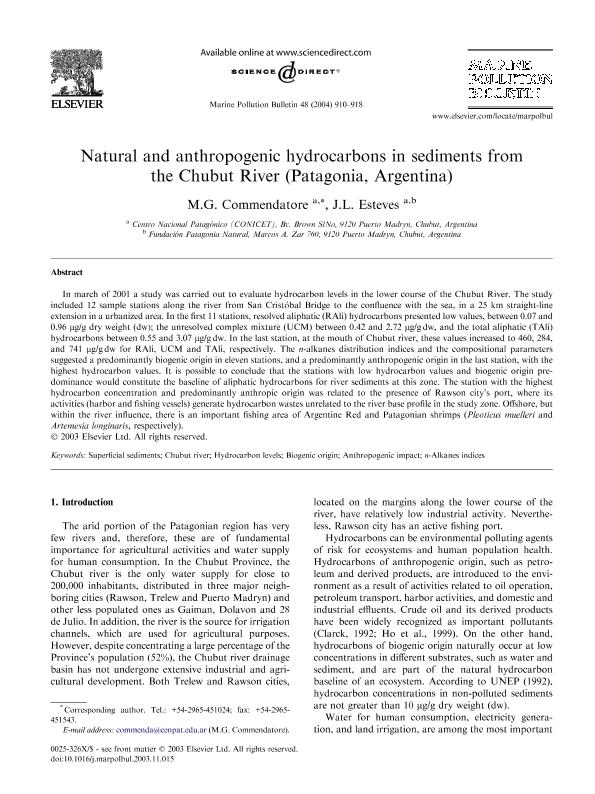Artículo
Natural and anthropogenic hydrocarbons in sediments from the Chubut River (Patagonia, Argentina)
Fecha de publicación:
05/2004
Editorial:
Pergamon-Elsevier Science Ltd
Revista:
Marine Pollution Bulletin
ISSN:
0025-326X
e-ISSN:
1879-3363
Idioma:
Inglés
Tipo de recurso:
Artículo publicado
Clasificación temática:
Resumen
In march of 2001 a study was carried out to evaluate hydrocarbon levels in the lower course of the Chubut River. The study included 12 sample stations along the river from San Cristobal Bridge to the confluence with the sea, in a 25 km straight-line extension in a urbanized area. In the first 11 stations, resolved aliphatic (RAli) hydrocarbons presented low values, between 0.07 and 0.96 lg/g dry weight (dw); the unresolved complex mixture (UCM) between 0.42 and 2.72 lg/g dw, and the total aliphatic (TAli) hydrocarbons between 0.55 and 3.07 lg/g dw. In the last station, at the mouth of Chubut river, these values increased to 460, 284, and 741 lg/g dw for RAli, UCM and TAli, respectively. The n-alkanes distribution indices and the compositional parameters suggested a predominantly biogenic origin in eleven stations, and a predominantly anthropogenic origin in the last station, with the highest hydrocarbon values. It is possible to conclude that the stations with low hydrocarbon values and biogenic origin predominance would constitute the baseline of aliphatic hydrocarbons for river sediments at this zone. The station with the highest hydrocarbon concentration and predominantly anthropic origin was related to the presence of Rawson city’s port, where its activities (harbor and fishing vessels) generate hydrocarbon wastes unrelated to the river base profile in the study zone. Offshore, but within the river influence, there is an important fishing area of Argentine Red and Patagonian shrimps (Pleoticus muelleri and Artemesia longinaris, respectively).
Archivos asociados
Licencia
Identificadores
Colecciones
Articulos(CCT-CENPAT)
Articulos de CTRO.CIENTIFICO TECNOL.CONICET - CENPAT
Articulos de CTRO.CIENTIFICO TECNOL.CONICET - CENPAT
Citación
Commendatore, Marta Graciela; Esteves, Jose Luis; Natural and anthropogenic hydrocarbons in sediments from the Chubut River (Patagonia, Argentina); Pergamon-Elsevier Science Ltd; Marine Pollution Bulletin; 48; 9-10; 5-2004; 910-918
Compartir
Altmétricas




